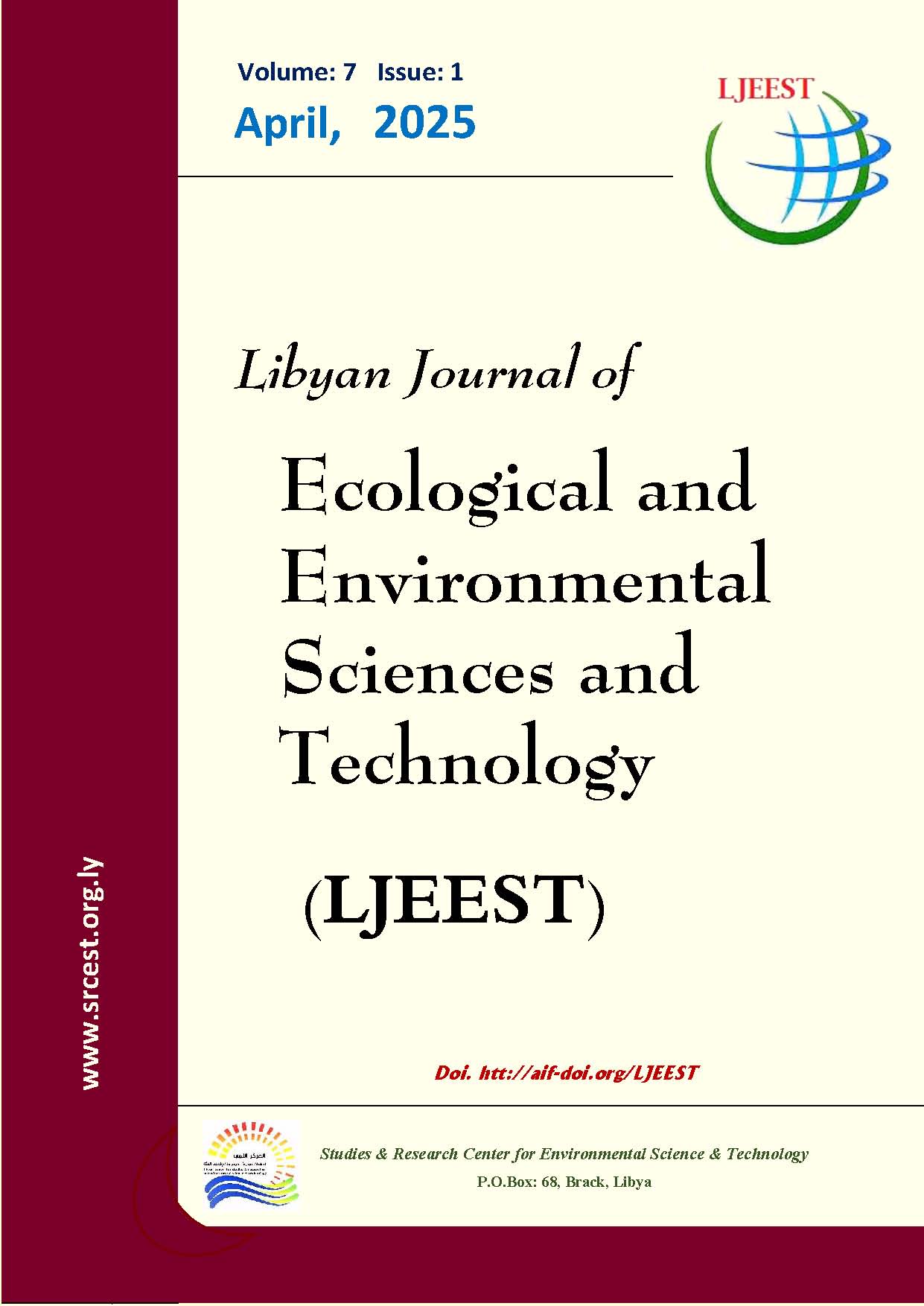Environmental Factors and Their Impact on Some Agricultural Products in Al-Jabal Al-Akhdar. Libya
DOI:
https://doi.org/10.63359/y5qw5876Keywords:
Climatic conditions, soil, agricultural pests, agricultural productionAbstract
Environmental changes directly affect agricultural activities, and environmental conditions play a vital role in determining the types of crops that can be planted, the timing of planting, the rate of production and product quality. 3areas have been identified in the Green Mountain (Butrabah, al Marj and Marawah) where some agricultural pests have spread, which caused damage to agricultural production. Soil and plant samples were collected and climatic data were monitored to determine the factors contributing to the spread of the pest of agricultural production damage. The prevalence of pests turned out to be similar in the three regions, Although the severity of the injury varies between regions. the butrabah region was the most affected compared to the rest of the regions, the reason may be due to the climatic conditions, where the humidity and temperature rates were high in the 2024 season, the January temperature ranged from 9-23C°while the relative humidity is 90 – 99%, which encouraged the appearance of agricultural pests early, This caused the stress of plants and reduced their ability to grow and absorb nutrients from the soil, which reflected on the quality of agricultural production, It is also considered that adding fertilizer rates to the soil randomly contributed to a contrast effect between some soil elements, which affected the availability of some elements such as calcium, which the plant needs during the fruiting stages mainly, In addition to not following a soil management program that promotes soil health, Where most farmers adopt preventive programs against fungi and insects during certain dates , due to the influence of environmental changes that contributed to the early onset of the injury, which affected the physiological qualities of the plant, which effectively affected the quality of food products, the results showed the inability of the plant to complete the production cycle and produce fruits suitable for consumption and marketing.
References
أبوقيلة، عمران ابوصلاح؛ عادل حسن أمين. 2005. أساسيات علم الأكاروسات. منشورات جامعة عمر المختار. دار الكتب الوطنية بنغازي-ليبيا.
أبو قيلة، عمران أبو صالح وعادل أمين.2005. حصر العوائل النباتية والأعداء الطبيعية للعنكبوت الأحمر ذو البقعتين (Acari : Tetranychidae) Tetranychus urtica Koch في بعض مناطق الجبل الأخضر، ليبيا، مجلة المختار للعلوم العدد الثاني.
المنشاوي عبد العزيز وعصمت حجازي. 1994. الآفات الحشرية والحيوانية وعلاقتها بالنبات والإنسان والحيوان وطرق مكافحتها، منشأة المعارف الإسكندرية مصر 621 صفحة.
خالد رمضان البيدى؛ عبد الباسط محمد حمودة. 2015. التغيرات المناخية وأثرها على الناتج الزراعي في ليبيا للفترة 1980-2010. مجلة علوم البحار والتقنيات البيئية, 1(2)، 58-69.
دسوقي، عبد المنعم سعيد سليمان. 2021. أساسيات علم الأكاروسات. قسم وقاية النبات. كلية الزراعة. جامعة سوهاج – مصر.
اللوح، منصور نصر. 2004. العلاقة بين الأمطار وبعض المتغيرات الجوية والطبيعية في الضفة الغربية، مجلة الجامعة الاسلامية، سلسلة الدراسات الإنسانية، المجلد الثاني عشر، العد الثاني.
OMU.2005. دراسة وتقييم الغطاء النباتي الطبيعي بمنطقة الجبل الأخضر. التقرير النهائي
Al-Abbasi, S. H.1981. Resistance To the Two-Spotted Spider Mite, Tetranychus urticae (Koch), In New Guinea Impatiens. Iowa State University.
Allison, L. E., and Richards, L. A.1954. Diagnosis And Improvement of Saline and Alkali Soils (No. 60). Soil And Water Conservative Research Branch, Agricultural Research Service, US Department of Agriculture.
Asif, M., Ahmad, S., Hasnain, M., Khakwani, K., Sarwar, G., Tauseef, M., ... and Jamil, M.2024. Infestation of Different Insect Pests on Novel Cotton Cultivars and Their Impacts on Cotton Fiber Quality Parameters. Agricultural Sciences Journal, 6(2), 73-83.
Bakr, A. A., and Selim, S .2019. Selective Biorational Treatments for Managing the Storage Mites, Tyrophagus Putrescentiae (Schrank) And Aleuroglyphus Ovatus (Troupeau) Under Laboratory Conditions. Systematic And Applied Acarology, 24(3), 337-347.
Carter, M. R. and Gregorich E. G. 2008. Soil Sampling and Methods of Analysis. Second Edition. Canadian Soc. Soil Sci., Boca Raton, FL: CRC Press, 1264 Pages.
Davis, R.M., T.A. Turini, B.J. Aegerter, And J.J. Stapleton. 2012. Cucurbits: Charcoal Rot-Macrophomina Phaseoli.
Dermauw, W., Wybouw, N., Rombauts, S., Menten, B., Vontas, J., Grbić, M., ... and Van Leeuwen, T. 2013. A Link Between Host Plant Adaptation and Pesticide Resistance in The Polyphagous Spider Mite Tetranychus Urticae. Proceedings of the National Academy of Sciences, 110(2), E113-E122.
Esri. 2016. Arc Map, Version. 10.5.0.6491. (Http:/Www.Esri.Com).
FAO (Food and Agriculture Organization). 2019. Production Yearbook, United Nations, Roma, Different Volumes. FAOSTAT Data [Available At: Http://Faostat.Fao.Org/Faostat].
FAO. 2000. Global Forest Resources Assessment, 2000. Main Report, FAO Forest Paoer 140- 455pp. Http://Www.Ipm.Ucdavis.Edu/PMG/R116101311.Html.
İnak, A., Demirci, B., Erdem, E., Randa-Zelyüt, F., Karanfil, A., Idan, A. Y., and Van Leeuwen, T. 2024. Insecticide Resistance Status and Vector Potential of Bemisia Tabaci Populations on Vegetable Crops in Türkiye. Crop Protection, 107097.
Jackson, M. L. 1973. Soil Chemical Analysis. Prentice-Hall (India) Pvt. Ltd. New Delhi.
Jensen, D.D. 1949. Papaya Virus Diseases with Special Reference to Papaya Ring Spot. Phytopathology. 39: 191–211
Jones Jr, J. B., and Case, V. W. 1990. Sampling, Handling, And Analyzing Plant Tissue Samples. Soil Testing and Plant Analysis, 3, 389-427.
Jones, S., Baizan-Edge, A., Macfarlane, S., and Torrance, L. 2017. Viral Diagnostics in Plants Using Next Generation Sequencing: Computational Analysis in Practice. Frontiers In Plant Science, 8, 1770.
Juroszek, P. and Von Tiedemann, A. 2013. Climatic Changes and The Potential Future Importance of Maize Diseases: A Short Review. Journal of Plant Diseases and Protection, 120: 49–56.
Juroszek, P., Racca, P., Link, S., Farhumand, J. and Kleinhenz, B. 2020. Overview on the Review Articles Published During the Past 30 Years Relating to The Potential Climate Change Effects on Plant Pathogens and Crop Disease Risks. Plant Pathology, 69: 179–193.
Kibblewhite, M. G. 2005. Soil Quality Assessment and Management. In Grassland: A Global Resource (Pp. 219-226). Wageningen Academic.
Kibblewhite, M. G., Ritz, K., and Swift, M. J. 2008. Soil Health in Agricultural Systems. Philosophical Transactions of The Royal Society B: Biological Sciences, 363(1492), 685-701.
Kumar, A., Sarma, A. S. R., Madhumathi, T., and Prasanna Kumari, V. 2017. Influence of Weather Parameters on The Occurrence of Major Insect Pests and Diseases of Paddy. Andhra Agricultural Journal, 64(1), 137-145.
Lehmann, J., Bossio, D. A., Kögel-Knabner, I., and Rillig, M. C. 2020. The Concept and Future Prospects of Soil Health. Nature Reviews Earth and Environment, 1(10), 544-553.
Maikhuri, R. K., and Rao, K. S. 2012. Soil Quality and Soil Health: A Review. Int. J. Ecol. Environ. Sci, 38(1), 19-37.
Mandal, A., Sarkar, B., Mandal, S., Vithanage, M., Patra, A. K., and Manna, M. C. 2020. Impact of Agrochemicals on Soil Health. In Agrochemicals Detection, Treatment and Remediation (Pp. 161-187). Butterworth-Heinemann.
Mann, G. S., and Dhooria, M. S. 1994. Activity And Abundance of Insects Visiting Guava Flowers in Punjab.
Mylavarapu, R., Sikora, F. J., and Moore, K. P. 2014. Walkley-Black Method. Soil Test Methods from The Southeastern United States, 158.
Neher, D. A., and Barbercheck, M. E. 2019. Soil Microarthropods and Soil Health: Intersection of Decomposition and Pest Suppression in Agroecosystems. Insects, 10(12), 414.
Nezhadakbarimahani, B., Kavousi, A., Nikbakht, J., and Rasoulifard, M. H. 2023. Magnetic Field as An Environmentally Friendly Tool Increases the Effectiveness of Pesticides: A Case Study of Acaricide Spirodiclofen Against Tetranychus Urticae Koch (Acari: Tetranychidae). Persian Journal of Acarology, 12(4), 571-580.
Reynaud, B., Delatte, H., Peterschmitt, M. and Fargette, D. 2009. Effects of Temperature Increase on The Epidemiology of Three Major Vector-Borne Viruses. European Journal of Plant Pathology, 123: 269–280.
Richerzhagen, D., Racca, P., Zeuner, T., Kuhn, C., Falke, K., Kleinhenz, B. and Hau, B. 2011. Impact of Climate Change on The Temporal and Regional Occurrence of Cercospora Leaf Spot in Lower Saxony. Journal of Plant Diseases and Protection, 118: 168–177.
Selkhoze Prom Express. 1980. Soil Studies in The Eastern Zone of Libya. Secretariat of Agriculture, Libya.
Shaibu, A.S., Li, B., Zhang, S. and Sun, J. 2020. Soybean Cyst Nematode-Resistance: Gene Identification and Breeding Strategies. The Crop Journal, 8(6): 892–904 [Online]. [Cited 29 December 2020]. Https://Doi.Org/10.1016/J.Cj.2020.03.001.
Sharma, S., Hooda, K.S. and Goswami, P. 2019. Scenario of Plant Diseases Under Changing Climate. Journal of Pharmacognosy and Phytochemistry, 8: 2490–2495.
Soil Survey Manual. 1993. (No. 18). The United States Dept. of Agriculture. Soil Survey Division, and United States. Division of Soil Survey. (1993). US Department of Agriculture.
Stern S.N. 2006. Stern Review: The Economics of Climate Change. HM Treasury, Cabinet office. [Available On: Http://Www.Hm.Treasury.Gov.Uk/Independent_Reviews/Stern_Review_Economics-_Climate_Change/Sternreview_Index.Cfm.
Trebicki, P. 2020. Climate Change and Plant Virus Epidemiology. Virus Research, 286: 198059. Https://Doi.Org/10.1016/J.Virusres.2020.198059.
Downloads
Published
Issue
Section
License
Copyright (c) 2025 Libyan Journal of Ecological & Environmental Sciences and Technology

This work is licensed under a Creative Commons Attribution-NonCommercial 4.0 International License.














